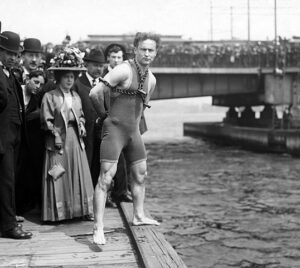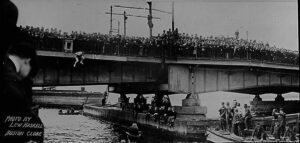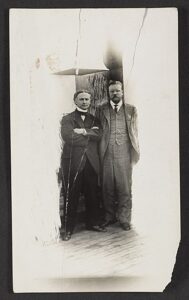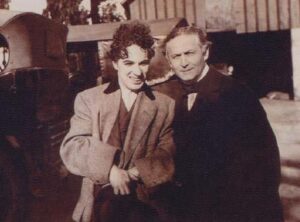Few personalities have achieved the worldwide fame and popularity of Harry Houdini. Successful in several different media ranging from vaudeville to motion pictures, this performer was also an astute businessman who incorporated both groundbreaking copyright implementation and sensational publicity to establish himself as the first 20th century entertainment superstar.

To publicize commercial appearances, the escape artist also began the practice of jumping handcuffed from bridges spanning whatever river ran through the city where he was performing. On May 6, 1907, when Houdini jumped from a bridge in Rochester, New York, he also incorporated the new phenomenon of motion pictures, a two minute clip of this exploit is still easily found on the internet today. Underwater for no more than fifteen seconds, Houdini quickly emerged, holding the now removed restraints in the air. Not only was this particular jump witnessed by an estimated ten thousand spectators, Houdini cleverly was able to exhibit the film footage in subsequent performances in theaters and arenas, cutting edge stuff in 1907. A subsequent jump in New Orleans, included not only handcuffs but chains wrapped around his limbs and padlocked at his throat. This required only about thirty seconds, before Houdini emerged, holding all of the restraints triumphantly over his head, as a transfixed audience of thousands watched from a Mississippi levee. Weather conditions also were circumvented, Houdini once jumping twenty five feet off of Detroit’s Belle Isle Bridge at the end of November, into the freezing Detroit River. Similar successful jumps occurred into Pittsburgh’s Allegheny and Boston’s Charles Rivers but the danger involved in these attempts was evidenced when a head first dive into the ocean from an Atlantic City pier in front of 20,000 people resulted in Houdini slamming his head into the ocean floor.

All of these escapades wound up routinely publicized on newspaper front pages all across America.

In Washington, DC, in January of 1906, he was placed in the former cell that confined Presidential assassin Charles J. Guiteau within the Murderer’s Row in the DC’s United States jail. Stripped of his clothing and thoroughly searched, he was then placed in Guiteau’s former cell, jail personnel leaving him there and returning to an exterior office. The cells were not only protected by sophisticated locks, they also featured a bar connected to the walls of the corridor, this bar also locked with a device that featured five tumblers and was unreachable from the inside of the cell. He emerged in two minutes, but then added the extra twist of opening the cells of all of the confined criminals and persuading them to exchange positions within the row, extricating his clothing from another cell and presenting himself to the warden in his office in a total of twenty-one minutes.

After observing the huge contracts obtained by such performers as Charlie Chaplin, his path became clear, especially when two young producers offered him a deal to star in an adaptation of Twenty Thousand Leagues under the Sea. Initially trumpeted as the highest amount of money to be paid for a performer in a motion picture up to that time, Houdini became the first of many artists to be disappointed by the promises of a film producer. The film was never made and he eventually sued and recovered a modest amount of money but this foray only solidified Houdini’s desire to stop touring and get heavily involved in film production.

Houdini’s distraction from performing was underlined by the undertaking of building a massive monument to his mother at her gravesite at the Jewish Machpelah cemetery in Queens. This granite and marble memorial underlined his practical obsession with his mother and also was eventually meant as a final resting place for himself, another reason for the ornate 1000 ton addition to this maternal shrine. A ceremony on October 1, 1916 attended by 250 guests in formal attire and Houdini in mourning garb evidenced the seriousness of the magician’s preoccupation with his mother’s passing.
Podcast: Play in new window | Download
Subscribe: RSS

Fascinating. Really enjoyed this podcast. Hope to hear more.
Glad you enjoyed it, It was suggested by a mutual acquaintance!